Toward a Rapid and Sustainable Recovery in the Tourism Industry Using Lean Manufacturing Principals
Abstract
1. Introduction
2. Literature Review
2.1. Lean Management Philosophy
2.1.1. The Use of Lean Management in Service Sector
2.1.2. Lean Management and Tourism
2.1.3. Lean Management and COVID-19
3. Group Technology and Data Collection
Clustering Algorithms and Data Collection
Single Linkage (Minimum Distance)
4. Data Collection
4.1. Data Clustering Analysis
- A.
- Clusters will be built based on different tourists depending on the proximity in the geographical areas from which they came and regardless of the tourist agencies that organized the tours.
- B.
- Clusters will be built based on different tourist agencies depending on the similarities of tourist nationalities for which offices organize trips.
4.1.1. Clustering Scenario, I (Tourist Nationalities)
- Transportation costs will be reduced for each tourist because all nationalities that have similar routes will go on the same trip, so the number of transportations used will be decreased and each one of the transportations will reach its full capacity, thus the individual cost will be reduced, and the offices will benefit from this idea because it saves money.
- The tourists for sure will feel psychological comfort because all people talk the same language, and have the same interests.
- The number of tourists on the trip will be small at each site, so the social distancing will be excellent and safety protocols will be used.
- This mechanism reduces the number of tourists on one route, so it will reduce the possibility of Coronavirus infection.
- Instead of each agency take its tourists from different nationalities with different routes to all places, this mechanism will take all nationalities on the same route on the same tourism trip, which will reduce the lost time on-road and save the transportation cost and then the economic cost to each office.
- It allows the creation of advanced tourist routes and protects the quality level of the services provided.
- Reducing the travel trips using this approach will contribute achieving the goals of the UN sustainability 17 goals, such as goal number 8, 9 and 12.
4.1.2. Clustering Scenario, II (Clusters of Offices Based on Tourist Nationalities)
- Transportation costs will be reduced for each agency because all the tourists in the handled by many agencies will go on the same trips, so the transportation cost will decrease.
- Give opportunities for tourists to form new relationships with different nationalities.
- The number of tour guides who will go on trips will be decreased so we can give the other tour guides the opportunity to make video clips for tourist places and make advertisements and then share them.
- Make organized trips and schedules to offices in the same cluster, which leads to saving time and effort.
5. Conclusions
Author Contributions
Funding
Informed Consent Statement
Data Availability Statement
Acknowledgments
Conflicts of Interest
References
- Scarlett, H. Tourism recovery and the economic impact: A panel assessment. Res. Glob. 2021, 3, 100044. [Google Scholar] [CrossRef]
- Camilleri, M.A. The tourism industry: An overview. In Travel Marketing, Tourism Economics and the Airline Product; Springer Nature: Cham, Switzerland, 2018; pp. 3–27. [Google Scholar] [CrossRef]
- Abbas, J.; Mubeen, R.; Iorember, P.T.; Raza, S.; Mamirkulova, G. Exploring the impact of COVID-19 on tourism: Transformational potential and implications for a sustainable recovery of the travel and leisure industry. Curr. Res. Behav. Sci. 2021, 2, 100033. [Google Scholar] [CrossRef]
- Ministry of Tourism and Antiquities. Information Center: Statistics. Jordan. 2022. Rose-Red City of Petra Wraps up 2019 with Record-Breaking 1,135,300 Visitors. By JT-Jan 06, 2020. Available online: https://jordantimes.com/news (accessed on 14 February 2023).
- Abu Al Haija, A. Jordan: Tourism and conflict with local communities. Habitat Int. 2011, 35, 93–100. [Google Scholar] [CrossRef]
- Manaf, M. Application of lean to hotel’s operations. In Proceedings of the 12th Biennial Conference of Hospitality and Tourism Industry in Asia (ATF-16), Bandung, Indonesia, 7–9 May 2016; Atlantis Press: Singapore, 2016; pp. 184–197. [Google Scholar]
- Brida, J.G.; Gómez, D.M.; Segarra, V. On the empirical relationship between tourism and economic growth. Tour. Manag. 2020, 81, 104131. [Google Scholar] [CrossRef]
- Diaz-Parra, I.; Jover, J. Overtourism, place alienation and the right to the city: Insights from the historic centre of Seville, Spain. J. Sustain. Tour. 2020, 29, 158–175. [Google Scholar] [CrossRef]
- Hosseini, K.; Stefaniec, A.; Hosseini, S.P. World Heritage Sites in developing countries: Assessing impacts and handling complexities toward sustainable tourism. J. Destin. Mark. Manag. 2021, 20, 100616. [Google Scholar] [CrossRef]
- Martins, L.F.; Gan, Y.; Ferreira-Lopes, A. An empirical analysis of the influence of macroeconomic determinants on World tourism demand. Tour. Manag. 2017, 61, 248–260. [Google Scholar] [CrossRef]
- Gannon, M.; Rasoolimanesh, S.M.; Taheri, B. Assessing the Mediating Role of Residents’ Perceptions toward Tourism Development. J. Travel Res. 2021, 60, 149–171. [Google Scholar] [CrossRef]
- Namberger, P.; Jackisch, S.; Schmude, J.; Karl, M. Overcrowding, Overtourism and Local Level Disturbance: How Much Can Munich Handle? Tour. Plan. Dev. 2019, 16, 452–472. [Google Scholar] [CrossRef]
- Ștefănică, M.; Sandu, C.B.; Butnaru, G.I.; Haller, A.-P. The Nexus between Tourism Activities and Environmental Degradation: Romanian Tourists’ Opinions. Sustainability 2021, 13, 9210. [Google Scholar] [CrossRef]
- Velikova, E. Methodological Guidelines for the Sustainable Development of the Bulgarian Touristic Resorts through Reducing the Harmful Impact of Transport. E3S Web Conf. 2019, 101, 01004. [Google Scholar] [CrossRef]
- Adie, B.A.; Falk, M.; Savioli, M. Overtourism as a perceived threat to cultural heritage in Europe. Curr. Issues Tour. 2020, 23, 1737–1741. [Google Scholar] [CrossRef]
- Little, C.; Bec, A.; Moyle, B.D.; Patterson, D. Innovative methods for heritage tourism experiences: Creating windows into the past. J. Heritage Tour. 2020, 15, 1–13. [Google Scholar] [CrossRef]
- Panasiuk, A. Policy of Sustainable Development of Urban Tourism. Pjst 2020, 27, 33–37. [Google Scholar] [CrossRef]
- Light, D.; Creţan, R.; Voiculescu, S.; Jucu, I.S. Introduction: Changing Tourism in the Cities of Post-communist Central and Eastern Europe. J. Balk. Near East. Stud. 2020, 22, 465–477. [Google Scholar] [CrossRef]
- Crețan, R.; Light, D.; Richards, S.; Dunca, A.-M. Encountering the victims of Romanian communism: Young people and empathy in a memorial museum. Eurasian Geogr. Econ. 2018, 59, 632–656. [Google Scholar] [CrossRef]
- Ansari, Y.; Arwab, M.; Subhan, M.; Alam, S.; Hashmi, N.I.; Hisam, M.W.; Zameer, M.N. Modeling Socio-Economic Consequences of COVID-19: An Evidence From Bibliometric Analysis. Front. Environ. Sci. 2022, 10, 941187. [Google Scholar] [CrossRef]
- Page, S.H.; Wu, D.C. Assessing the Impacts of the Global Economic Crisis and Swine Flu on Inbound Tourism Demand in the United Kingdom. J. Travel Res. 2012, 51, 142–153. [Google Scholar] [CrossRef]
- Azmi, F.M.; Khan, H.N.; Azmi, A.M.; Yaswi, A.; Jakovljevic, M. Prevalence of Covid-19 Pandemic, Self-Esteem and its Effect on Depression among University Students in Saudi Arabia. Front. Public Health 2022, 10, 3. [Google Scholar] [CrossRef]
- Diab, A.A. THE IMPACT OF THE COVID-19 PANDEMIC ON ORGANIZATIONAL PRACTICES: A REVIEW STUDY. J. Leg. Ethical Regul. Issues 2022, 25, 1–8. [Google Scholar]
- Almustafa, K.M. Covid19-Mexican-Patients’ Dataset (Covid19MPD) Classification and Prediction Using Feature Importance. Concurr. Comput. Pract. Exp. 2022, 34, e6675. [Google Scholar] [CrossRef] [PubMed]
- Japutra, A.; Situmorang, R. The repercussions and challenges of COVID-19 in the hotel industry: Potential strategies from a case study of Indonesia. Int. J. Hosp. Manag. 2021, 95, 102890. [Google Scholar] [CrossRef] [PubMed]
- Cahyadi, H.S.; Newsome, D. The post COVID-19 tourism dilemma for geoparks in Indonesia. Int. J. Geoheritage Park. 2021, 9, 199–211. [Google Scholar] [CrossRef]
- Akbulaev, N.; Aliyev, V. The effect of coronavirus SARS-CoV-2 in the tourism industry in Africa. J. Environ. Manag. Tour. 2020, 11, 1938–1947. [Google Scholar]
- Wen, J.; Kozak, M.; Yang, S.; Liu, F. COVID-19: Potential effects on Chinese citizens’ lifestyle and travel. Tour. Rev. 2021, 76, 74–87. [Google Scholar] [CrossRef]
- Chang, C.L.; McAleer, M.; Ramos, V. A charter for sustainable tourism after COVID-19. Sustainability 2020, 12, 3671. [Google Scholar] [CrossRef]
- Vlachos, I.; Bogdanovic, A. Lean thinking in the European hotel industry. Tour. Manag. 2013, 36, 354–363. [Google Scholar] [CrossRef]
- Arfmann, D.; Barbe, G.T. The value of lean in the service sector: A critique of theory & practice. Int. J. Bus. Soc. Sci. 2014, 5, 18–24. [Google Scholar]
- Caretta Teixeira, J.C.; Bernardi, F.A.; Lopes Rijo, R.P.C.; Alves, D. Proposal for a health information management model based on Lean thinking. Procedia Comput. Sci. 2021, 181, 1097–1104. [Google Scholar] [CrossRef]
- Bloj, M.D.; Moica, S.; Veres, C. Lean six sigma in the energy service sector: A case study. Procedia Manuf. 2020, 46, 352–358. [Google Scholar] [CrossRef]
- Tuan, L.T. Tourism employee ambidexterity: The roles of servant leadership, job crafting, and perspective taking. J. Hosp. Tour. Manag. 2022, 51, 53–66, ISSN 1447-6770. [Google Scholar] [CrossRef]
- Al-Aomar, R.; Hussain, M. An assessment of adopting lean techniques in the construct of hotel supply chain. Tour. Manag. 2018, 69, 553–565. [Google Scholar] [CrossRef]
- Kaushal, V.; Srivastava, S. Hospitality and tourism industry amid COVID-19 pandemic: Perspectives on challenges and learnings from India. Int. J. Hosp. Manag. 2021, 92, 102707. [Google Scholar] [CrossRef] [PubMed]
- Rauch, E.; Damian, A.; Holzner, P.; Matt, D.T. Lean hospitality-Application of lean management methods in the hotel sector. In Proceedings of the 48th CIRP Conference on Manufacturing Systems-CIRP CMS, Naples, Italy, 3–5 June 2015; Elsevier: Amsterdam, The Netherlands, 2016; pp. 614–619. [Google Scholar]
- Guillermo, C.C. Application of Lean Management to the Tourism, Hotel and/or Restaurant Sector. Bachelor’s Thesis, Escola Politécnica Superior d’Enginyeria de Vilanova i la Geltrú, Barcelona, Spain, 2018. [Google Scholar]
- Hundal, G.S.; Thiyagarajan, S.; Alduraibi, M.; Laux, C.M.; Furterer, S.L.; Cudney, E.A.; Antony, J. Lean Six Sigma as an organizational resilience mechanism in health care during the era of COVID-19. Int. J. Lean Six Sigma 2021, 12, 762–783. [Google Scholar] [CrossRef]
- Leite, H. The role of lean in healthcare during COVID-19 pandemic. Int. J. Qual. Reliab. Manag. 2022; ahead-of-print. [Google Scholar] [CrossRef]
- Muhammad, N.; Upadhyay, A.; Kumar, A.; Gilani, H. Achieving operational excellence through the lens of lean and Six Sigma during the COVID-19 pandemic. Int. J. Logist. Manag. 2022, 33, 818–835. [Google Scholar] [CrossRef]
- Pellini, F.; Di Filippo, G.; Mirandola, S.; Deguidi, G.; Filippi, E.; Pollini, G.P. Effects of Lean Thinking and Emerging Technologies on Breast Cancer Patients’ Therapeutic Process During COVID-19 Pandemic: A Case-Control Matched Study. Front. Surg. 2021, 8, 582980. [Google Scholar] [CrossRef]
- Abdelhadi, A. Lean Manufacturing Application to Control The Spread of The COVID-19. J. Leg. Ethical Regul. Issues 2021, 24, 1–8. [Google Scholar]
- Burbidge, J.L.; Grubbström, R.W. The first step in planning group technology. Int. J. Prod. Econ. 1996, 43, 261–266. [Google Scholar] [CrossRef]
- Jarman, A.M. Hierarchical Cluster Analysis: Comparison of Single Linkage, Complete Linkage, Average Linkage and Centroid Linkage Method; Georgia Southern University: Statesboro, Georgia, 2020. [Google Scholar] [CrossRef]
- Dabhi, D.P.; Patel, M.R. Extensive Survey on Hierarchical Clustering Methods in Data Mining. Int. Res. J. Eng. Technol. (IRJET) 2016, 3, 659–665. [Google Scholar]
- Vladimir Estivill-Castro. Why so many clustering algorithms: A position paper. ACM SIGKDD Explor. Newsl. Homepage Arch. 2002, 4, 65–75. [Google Scholar] [CrossRef]
- Dinh, D.T.; Fujinami, T.; Huynh, V.N. Estimating the Optimal Number of Clusters in Categorical Data Clustering by Silhouette Coefficient. In Knowledge and Systems Sciences; Chen, J., Huynh, V., Nguyen, G.N., Tang, X., Eds.; Springer: Singapore, 2019; Volume 1103. [Google Scholar] [CrossRef]
- Forina, M.; Armanino, C.; Raggio, V. Clustering with dendrograms on interpretation variables. Anal. Chim. Acta 2002, 454, 13–19. [Google Scholar] [CrossRef]
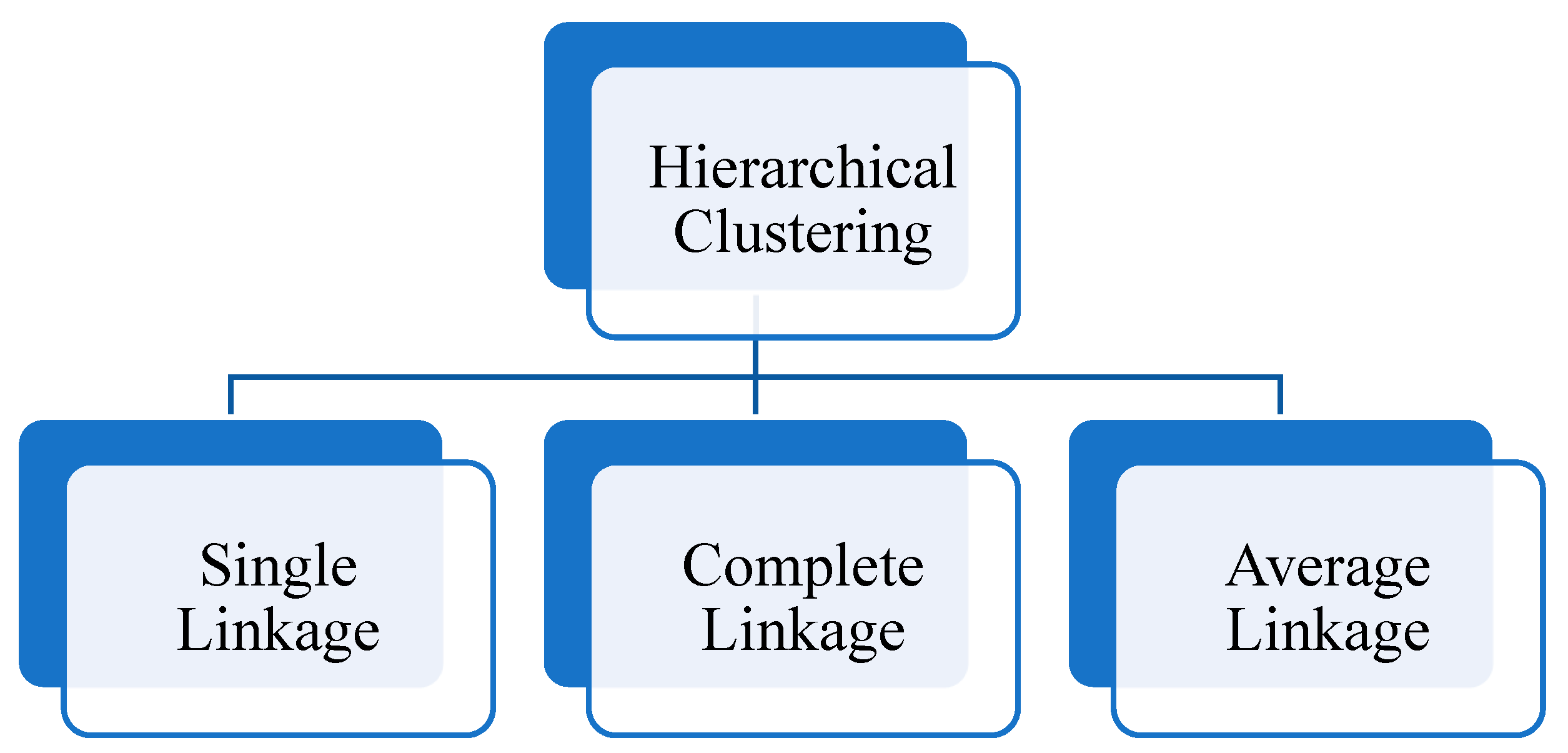

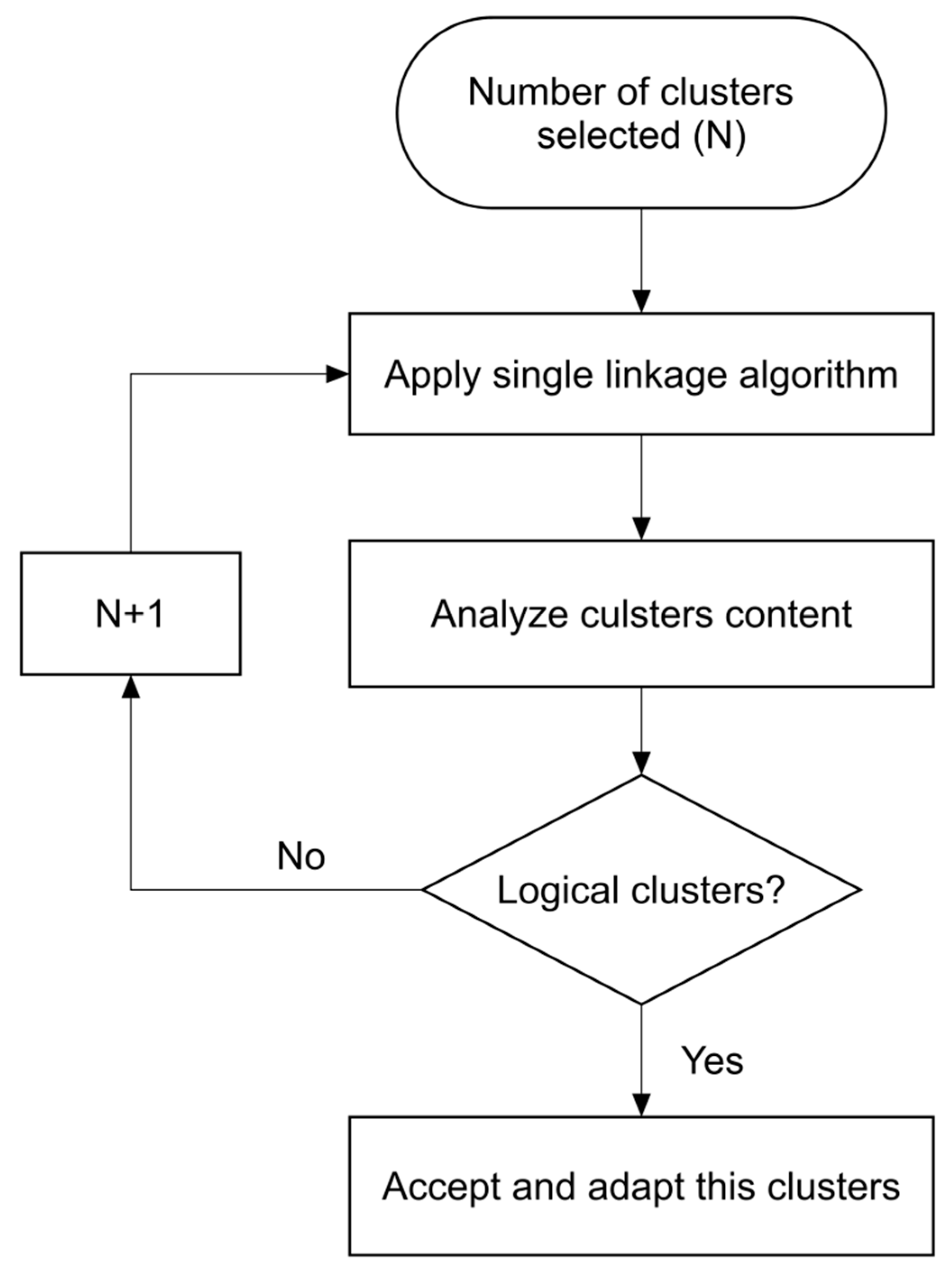
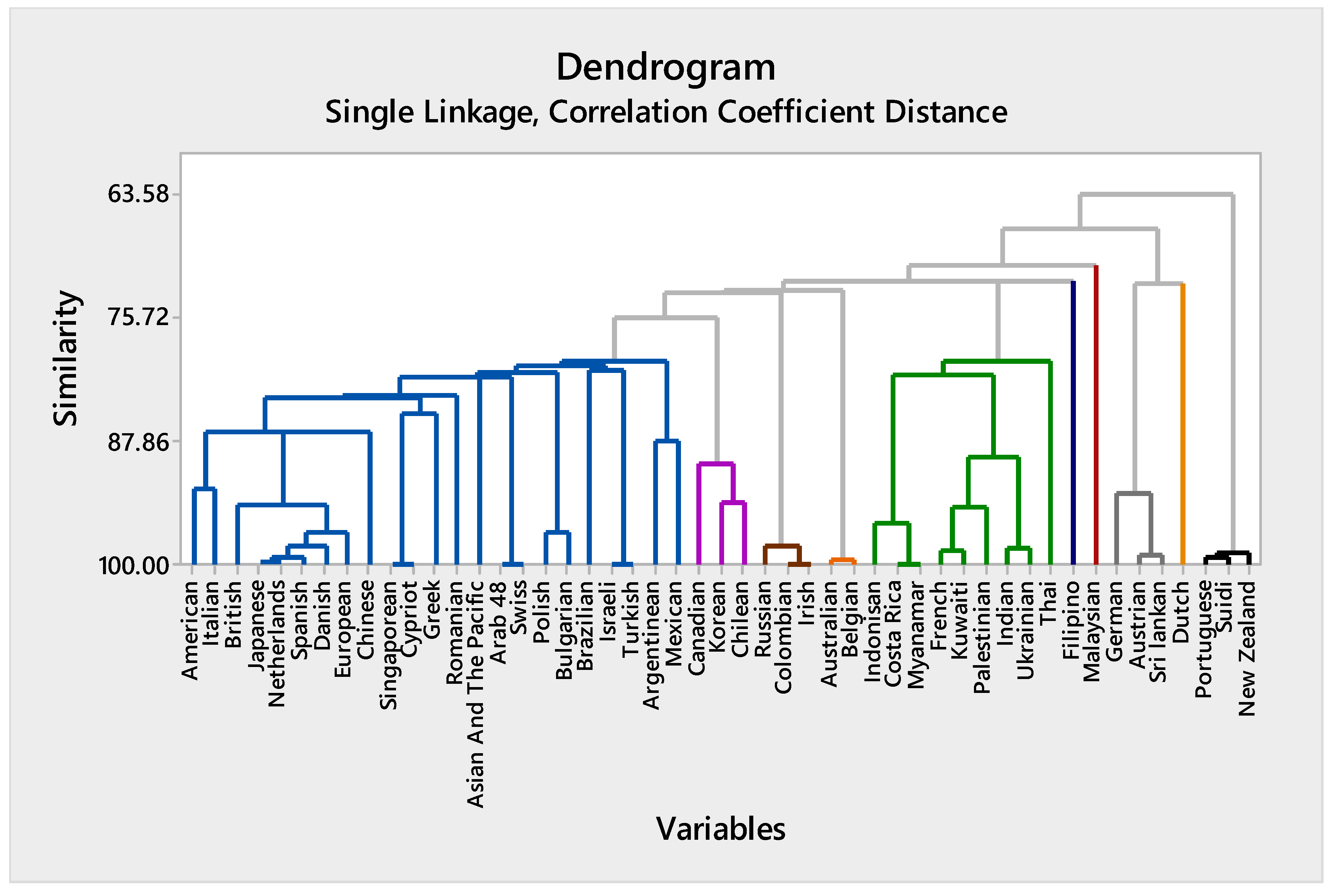
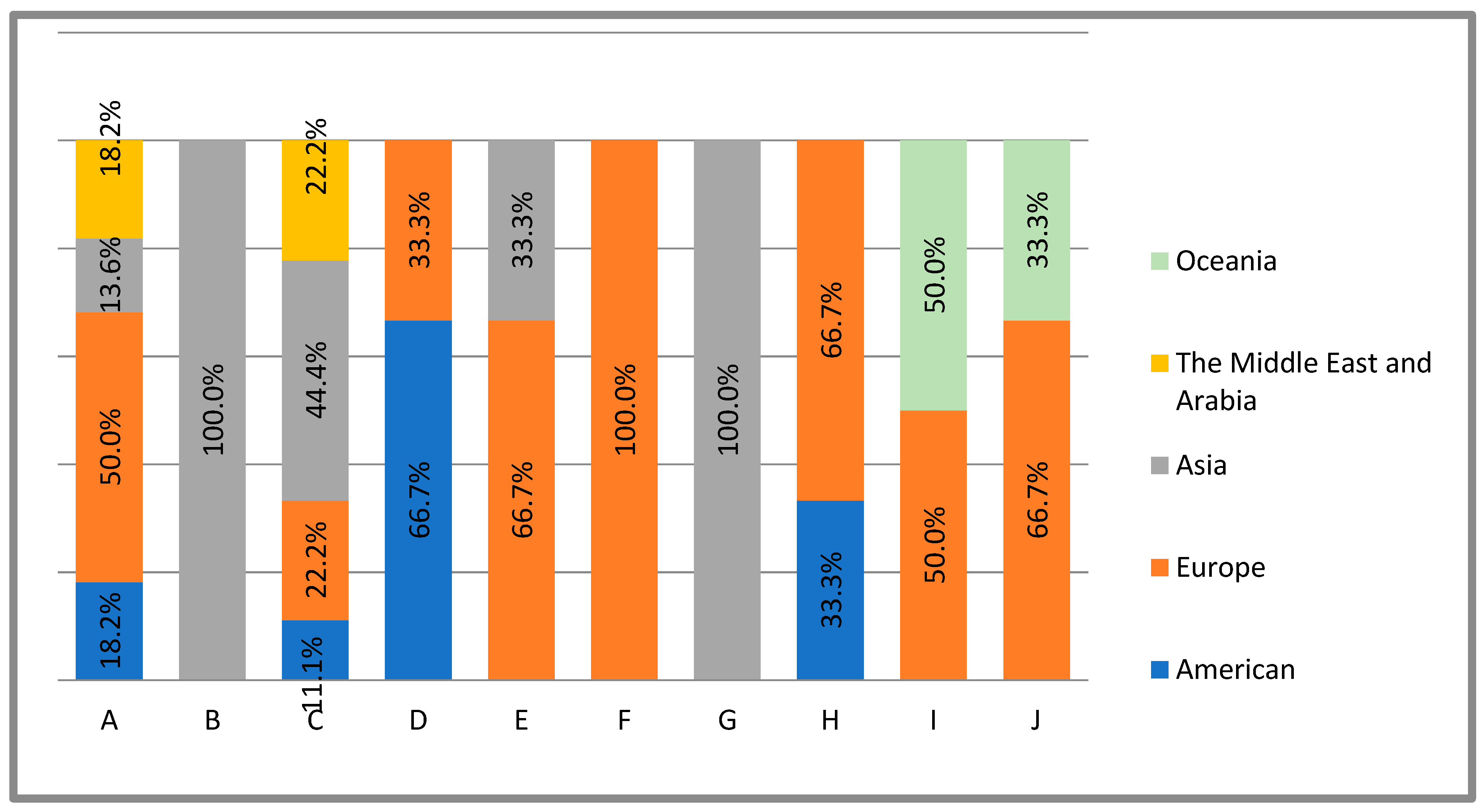

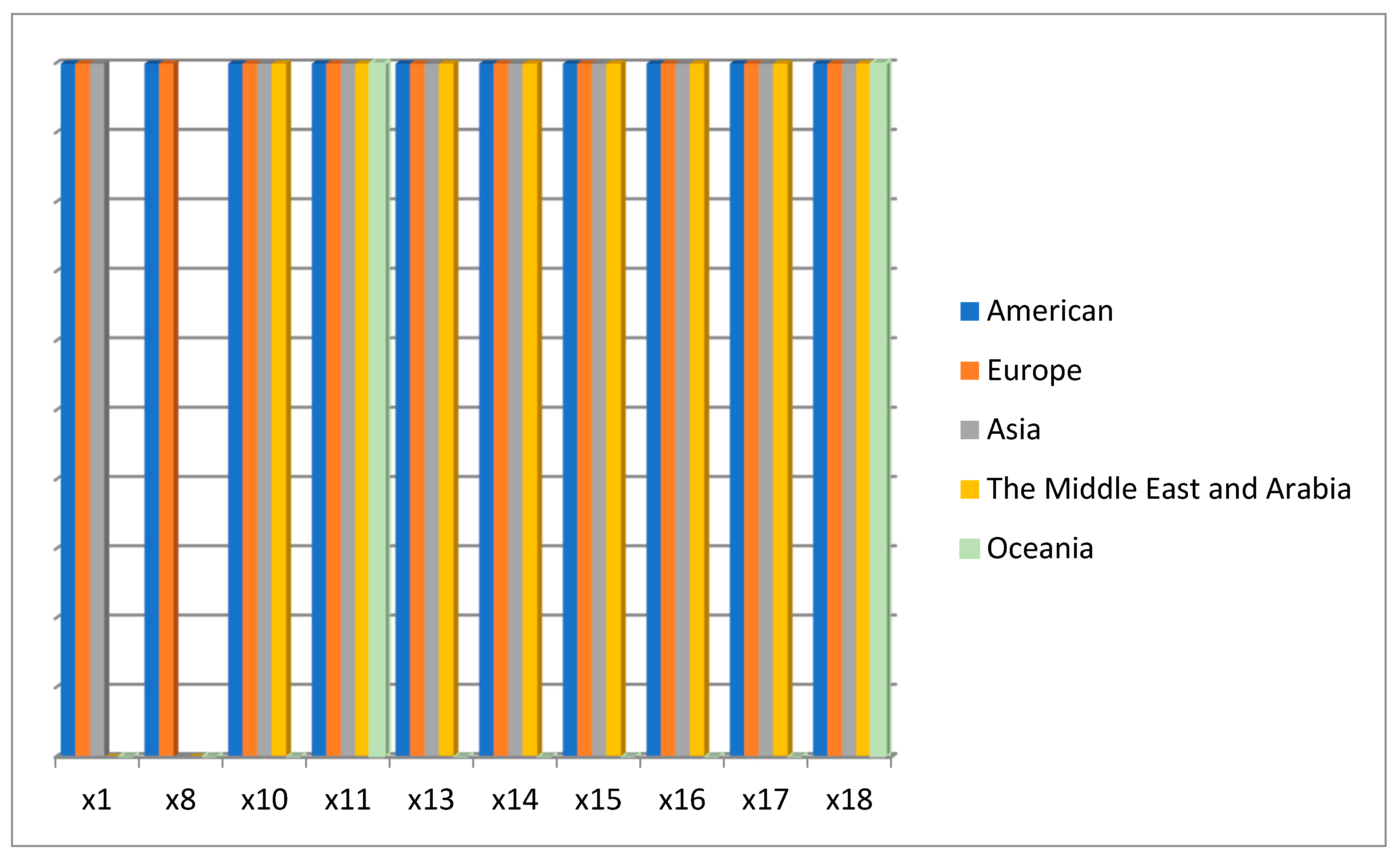
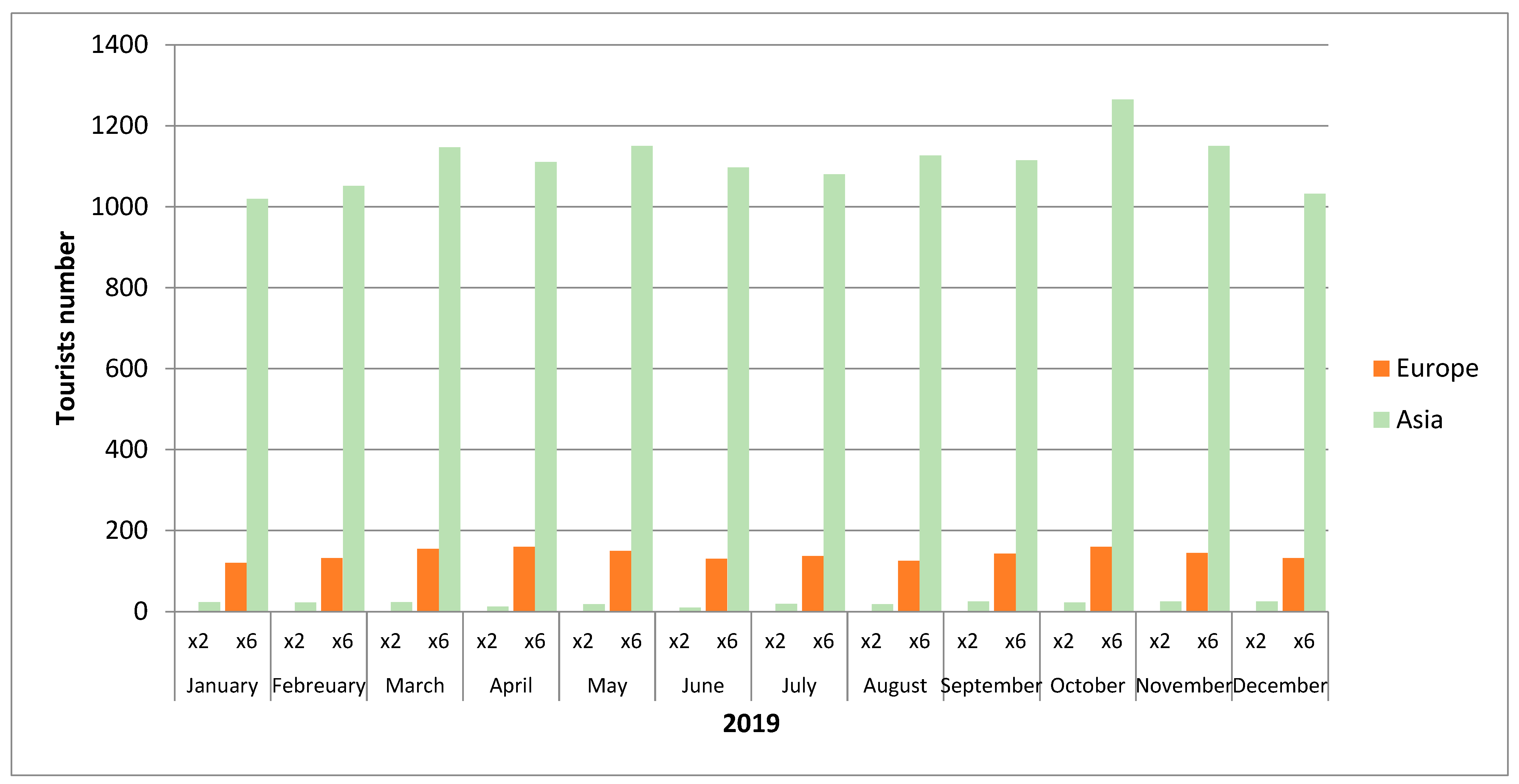
| Month | Clusters | Nationalities |
|---|---|---|
| January, 2019 | A | American, Italian, British, Chinese, Japanese, Spanish, Argentinean, Mexican, Brazilian Romanian, Singaporean, Cypriot, Greek, Israeli, Netherlands, Asian And The Pacific, European, Swiss, Polish, Bulgarian, Danish, Turkish |
| B | Malaysian | |
| C | Indonesian, French, Indian, Thai, Palestinian, Costa Rica, Ukrainian, Kuwaiti, Myanmar | |
| D | Canadian, Korean, Chilean | |
| E | German, Austrian, Sri Lankan | |
| F | Dutch | |
| G | Filipino | |
| H | Russian, Colombian, Irish | |
| I | Australian, Belgian | |
| J | Portuguese, Saudi, New Zealand |
| Months | Cluster A | Cluster B | Cluster C | Cluster D | Cluster E | Cluster F | Cluster G | Cluster H |
|---|---|---|---|---|---|---|---|---|
| February | ×1, ×16, ×17, ×18 | ×2, ×6 | ×3 | ×4 | ×5, ×7 | ×9 | ×10, ×11, ×12, ×13, ×14, ×19 | ×15 |
Disclaimer/Publisher’s Note: The statements, opinions and data contained in all publications are solely those of the individual author(s) and contributor(s) and not of MDPI and/or the editor(s). MDPI and/or the editor(s) disclaim responsibility for any injury to people or property resulting from any ideas, methods, instructions or products referred to in the content. |
© 2023 by the authors. Licensee MDPI, Basel, Switzerland. This article is an open access article distributed under the terms and conditions of the Creative Commons Attribution (CC BY) license (https://creativecommons.org/licenses/by/4.0/).
Share and Cite
Almomani, M.A.; Alshatnawi, E.M.; Abdelhadi, A.N. Toward a Rapid and Sustainable Recovery in the Tourism Industry Using Lean Manufacturing Principals. Appl. Sci. 2023, 13, 2529. https://doi.org/10.3390/app13042529
Almomani MA, Alshatnawi EM, Abdelhadi AN. Toward a Rapid and Sustainable Recovery in the Tourism Industry Using Lean Manufacturing Principals. Applied Sciences. 2023; 13(4):2529. https://doi.org/10.3390/app13042529
Chicago/Turabian StyleAlmomani, Mohammed A., Eman M. Alshatnawi, and Abdelhakim N. Abdelhadi. 2023. "Toward a Rapid and Sustainable Recovery in the Tourism Industry Using Lean Manufacturing Principals" Applied Sciences 13, no. 4: 2529. https://doi.org/10.3390/app13042529
APA StyleAlmomani, M. A., Alshatnawi, E. M., & Abdelhadi, A. N. (2023). Toward a Rapid and Sustainable Recovery in the Tourism Industry Using Lean Manufacturing Principals. Applied Sciences, 13(4), 2529. https://doi.org/10.3390/app13042529






